2005 January
About Andrew Cusack
 Writer, web designer, etc.; born in New York; educated in Argentina, Scotland, and South Africa; now based in London.
Writer, web designer, etc.; born in New York; educated in Argentina, Scotland, and South Africa; now based in London. read more
News
Blogs
Reviews & Periodicals
Arts & Design
World
France
Mitteleuropa
Knickerbockers
Argentina
The Levant
Africa
Cape of Good Hope
Netherlands
Scandinavia
Québec
India
Muscovy
Germany
Academica
Elliott Banfield
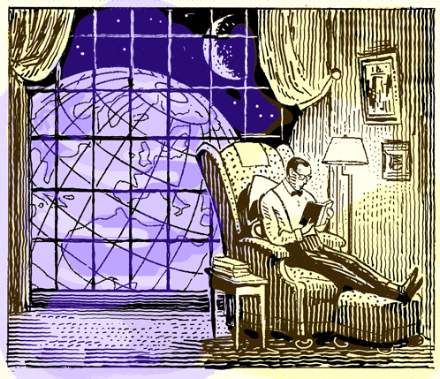
One of the best illustrators alive is Elliott Banfield. I have seen his work a few times in the New York Sun, but only managed to finally investigate him on the web this evening (thanks to the Irish Elk), and his website offers a plethora of wonderful retro illustrations that prove his skill and his worth. Why, if I ran a newspaper – one with a real budget I mean – I’d have this guy be the in-house illustrator and might be tempted to ditch photographs altogether.
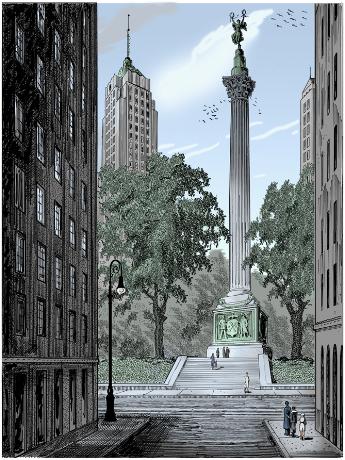
Mr. Banfield even gives us a wonderful impression of his proposal for a September 11 monument, inspired by critic Henry Reed. I love it. It oozes Gotham and reeks of Manhattan. I especially enjoy the use of New York’s civic arms on the base of the pillar, supported, appropriately, by a policeman and a fireman, rather than the official settler and native. The heraldic achievement of our city is, I’ll admit, somewhat provincial with its windmills and beavers, but all the more endearing for it, if you ask me.
Huzzah for Elliott Banfield!
Our Favorite Bishop Writes!
I have been ill the past four or five days, but there was nothing that could have made me feel better than having recently received the following email:
Thank you for the publication about my visit in your The Mitre of November I received here by our friend Carlos Colon. May God bless allways your work and apostolate among the students. I show your publication to our priests and youngmen as an example to be immitated.
With my best wishes and blessing.
Stained-Glass Window
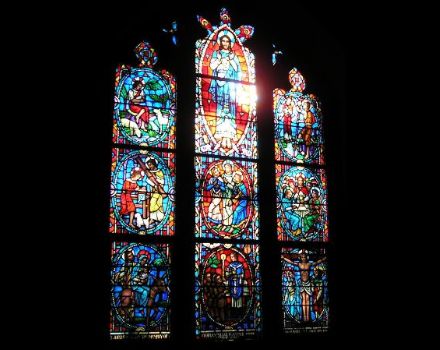
Here’s a window from the Goodhue-designed Christ Church Bronxville, with a close-up of one panel below.
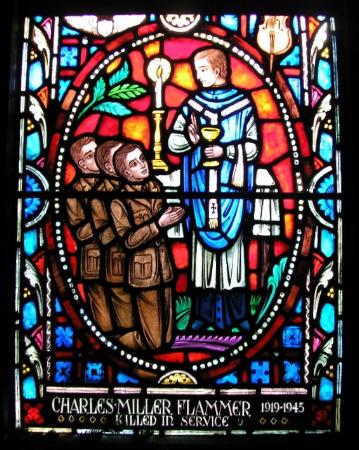
To Yale and Back Again
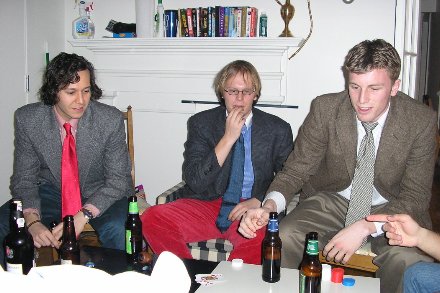
An altogether successful foray was made last night into the neighboring sovereign state of Connecticut, wherein resides a middle-aged (or perhaps even old, by our national standards) university which is named Yale, after the institution’s early benefactor. Said place of higher learning is also home to the burgeoning second chapter of the greatest society ever to have graced the University and Royal Burgh of St Andrews. It was in such a capacity that I was invited along to a moderately informal and very cheerful evening. (more…)
The Dewey Arch
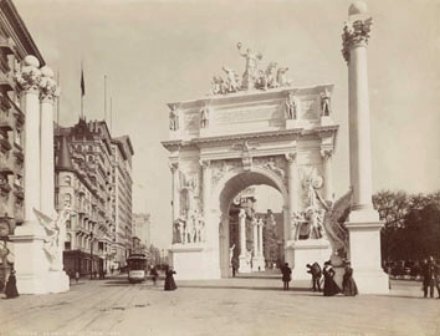
The Classical Values blog had a post back in October ’03 entitled A Classical Arch in New York, which makes mention of the triumphal arch built to comemmorate Admiral Dewey’s victory over the Spanish in the eponymous war between our two nations round the turn of the century.
The Dewey Arch was only a temporary structure built of a plaster-like material, and thus did not survive. A previous temporary wood-and-plaster triumphal arch was built to commemorate General Washington in Washington Square, and proved so popular that it was decided to replace it with a permanent stone version. Unfortunately, the more attractive beaux-arts Dewey Arch, which also featured a colonnade, was not made permanent as its location in Madison Square would have obstructed the flow of vehicles and required a rethinking of the traffic flow.
The only existing reminder of the Arch near the site is a bar and restaurant called Dewey’s Flatiron.
Nonetheless, here are a few photos of the lost arch.
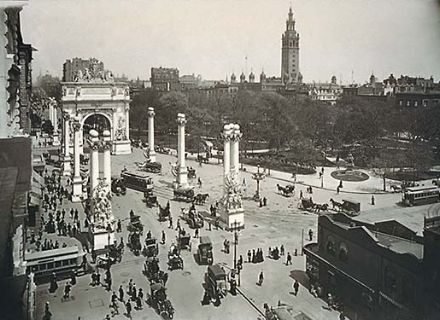
A view of the Dewey Arch, colonnade, and Madison Square, with Stanford White’s towered Madison Square Garden in the background. Broadway and its trolley line cross the colonnade’s axis. (more…)
New Eyewitness Goes Blind
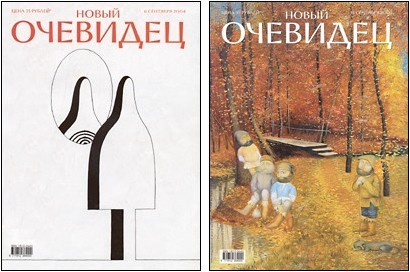
 Novy Ochevidets, Russia’s blatant imitation of the New Yorker is shutting down after only five months in operation, according to the Moscow Times.
Novy Ochevidets, Russia’s blatant imitation of the New Yorker is shutting down after only five months in operation, according to the Moscow Times.
Novy Ochevidets, which translates as the ‘New Eyewitness’, specially commissioned a Cyrillic font that fashioned after that of its mentor, and even had it’s own version (seen at right) of the New Yorker‘s classic fopp, Eustace Tilly.
I mourn for the New Yorker. It has yet to recover from Tina Brown’s years at the helm, and shows no signs of getting better. Indeed, quite the opposite, as was shown this past year when the magazine endorsed a political candidate for the first time in its history. (If you hadn’t already guessed, it was the man perenially described by James Taranto as ‘the haughty French-looking senator from Massachusetts who, by the way, also served in Vietnam’).
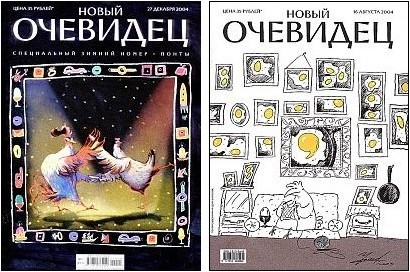
Via the indispensible Arts & Letters Daily.
The Death of an Intellectual
I have but one thing to say about the late Susan Sontag: Nearly every obituary of the intellectual reminds us that “she often described herself as a ‘zealot of seriousness'”. That someone would, in all seriousness, put themselves forth as a ‘zealot of seriousness’ makes it bordering on impossible for me to take her seriously.
Nonetheless, may she rest in peace.
Res Publica Nova Eboraci

Gothamist picks up the idea of the City of New York seceding from either the State or the Country. Normally I’m in favor of anything seceding from anything else. However, the City and State have to stick together. I wouldn’t mind the State of New York regaining complete sovereignty, but I think we’d want to take Connecticut and northern New Jersey with us for the sake of geographic integrity.
New York currency illustrations from an article on secession in New York magazine.
Leisure
I AM BACK HOME in New York after having completed my Martinmas term examinations. This morning, my mother, sister, brother-in-law, and I went out for breakfast to celebrate my “triumphant return from another term at university.” (I suggested it might be wiser to wait until the casualty reports are released before we declare it a triumph).
Nonetheless, I now have three weeks of time almost entirely free from obligations to do whatever I please. It is perhaps how a man spends his free time that defines him, as free time is the foundation of civilization itself. Roger Kimball reflects on this in a recent Armavirumque posting, mentioning Josef Pieper and Leisure: The Basis of Culture, a book I was first introduced to by Robert O’Brien whilst still half-asleep at 7:30 in the morning waiting for a train at Leuchars station so we could attend the Tridentine mass in Edinburgh.
Leisure, by which we mean doing something merely for its own sake, is entirely different from mere pleasure. Unfortunately for the English language, we oft mistake the two for synonyms. It is leisure in that latter sense, of idleness and cheap pleasure, which our good friend Prof. Richard Demarco resoundly condemned in a lecture he gave at St Andrews. This kind of leisure, he stated, was leading to the destruction of Scotland, of Europe, and of civilization. Art today, according to Richard, is a collection of usually talentless kitsch which seeks merely to create an arrangement that is pleasing or clever. Art, in Richard Demarco’s world, should not aim to be pleasing, or to be clever, but should have as its essence the very highest that man can achieve: the sanctification of souls. In pursuit of pleasure rather than leisure, tourism is taking over entire countries; a false economy which can enslave the entire population of a given area.
It is certainly rampant in St Andrews. There are many good reasons to visit St Andrews. The third-oldest university in the English-speaking world, for example, or perhaps to see ruins of one of the greatest shrines in Christendom, bearing witness to the visceral damage wrought by the Protestant Revolution (we should refuse to dignify that revulsion with the name of ‘reformation’; it destroyed and replaced, not reformed). Most, however, come for the golf.
While niches once full remain empty from the holocausts of five centuries ago, the Scottish Parliament would prefer to spend its millions (which, you must never forget, are the people’s millions) on encouraging this pointless and ineffective idleness, Demarco pointed out. More recently, South Street, where I live, will soon be shorn of its beautiful trees, those which make it one of the most inviting and comely thoroughfares in the Royal Burgh. This must be done, we are told, to increase the number of parking spaces, the paucity of which might be driving away potential tourists. Perish the thought! Heaven forbid a town be run for the benefit of its inhabitants, for the benefit of itself (but surely by now they have already forbidden Heaven).
As Mr. Kimball points out, the opposite of the former leisure, the leisure which Pieper posits is the basis of culture, is busyness. Perhaps we can extend this to business, for it is the dollar, the pound, and the euro which enslave St Andrews to transient tourists. Without tourism, some say, St Andrews, or Oxford or Venice or wherever, would not survive. But at what price survival? And who defines this survival? That these places are still on the map and are inhabited is for sure. But in some sense have not these places, while encouraging tourism as a mode of survival, been so changed and transformed that in fact they have not survived. Decrepit and rundown, they may have been, but at least they had authenticity; at least they were themselves. Now most of the goods sold in St Andrews – saltires, fake kilts, tam o’shanters, and Scotland t-shirts – are in fact things that can be purchased in half the towns in Scotland, and now with the advent of the internet, you can purchase them while you remain at home. Their cheapness is only accompanied by the sentiment of being a souvenir in the original French sense of the word: to remember. But they are remembrances for short memories, and likely will be thrown out within a year, because we, and it all comes back to this, do not have the time for longer memories.
Thus one of the chief values of an education must be free time. St Andrews affords this, I am glad to say; especially if you are an arts student and are not aiming for a first. All too often friends of mine at universities in the States or at Oxbridge are busy. They are either busy with busywork, (assignments for school which must be done to stay in the university but have little graded value or academic merit) or else busy with social activity and other amusements which vary greatly as to whether one’s in a big city or not (most often the case with NYU students I find).
When I finally start my university, we must make sure that students have enough free time then, perhaps the greatest argument for not locating it in an overactive urban metropolis. Though of course a good part of education is that which transmits information and ideas and, more importantly, inculcates moral values, much must be left up to the student. There is an inherent value in reading not what is required but what is desired.
And so I will get on with my post-exam break, reading the Pickwick Papers, the Everlasting Man, and This Side of Paradise, hopefully with some time to browse through Haldane’s Faithful Reason: Essays Catholic and philosophical (which, on a typographical note, makes ample use of the Gill Sans font).
More Recent Photos

Here’s a glimpse of life at St Andrews and elsewhere. Most of them I took, though some were stolen from Clara and elsewhere. Above are Fraulein von Hauch and Mrs. Freeburn after having divided a chocolate bunny for their own consumption. (more…)
About Time
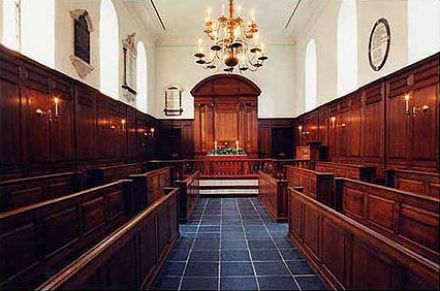
The Chicago Tribune reports that three of Virginia’s best public universities are seeking to privatise. I’ve often thought that it’s about time the College of William & Mary returned to the private sector. If only because it would allow them to keep a cross in their beautiful Wren-designed chapel full time (see above). But of course, given the state of academia today, that’s unlikely anyhow. W&M only became public around 1912 if my memory serves me well. Similar proposals have been aired in South Carolina, especially in regards to the more prestigious of its public colleges, the College of Charleston (f. 1770), and the Citadel, the Military College of South Carolina.
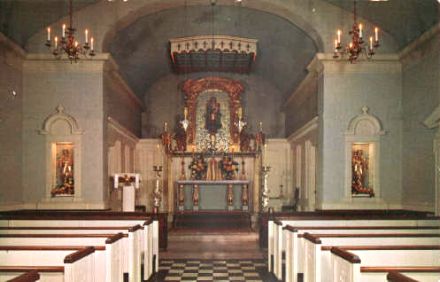
Williamsburg is also home to St. Bede’s Church, which was once also the American Shrine of Our Lady of Walsingham. The parish is now the largest “faith community” in Williamsburg, but seems to have faltered in its devotion to Our Lady. Due to its increasing size, a dodgy new round church is being built.
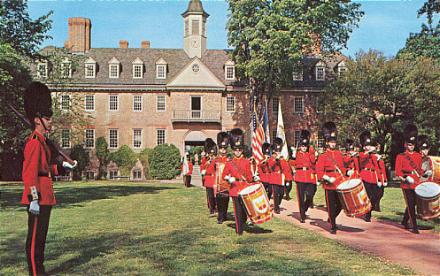
The officers-in-training from the College of William and Mary form the Queen’s Guard, named so in recognition of the honors bestowed upon the College by Queen Mary II, Queen Anne, and Queen Elizabeth II.
Warner on the Gotha
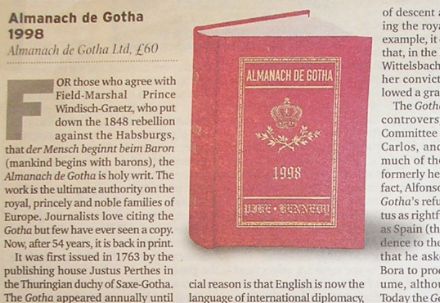
Whilst rummaging through my room at home in New York last week, I came across this article which I had cut out of the ill-fated European in 1998 written by none other than Mr. Gerald Warner, KM. I was fourteen years old in 1998 and the European folded about a year later. Click here to read in jpg form. (A large file, some browsers may require resizing to view the text at a readable size).
Travels
I’m back off to Caledonia this evening for my examinations. But I’m back to New York by the evening of next Sunday anyhow, so I’m not gone for long.
For a peek at what our exams are actually like, here are the questions from last year’s exam for “MO3322 French Algeria 1830-1962”. Three questions must be answered in the space of three hours.
2. To what extent did Algerian resistance obstruct the extension of French control in Algeria between 1830 and 1871?
3. ‘For a settler to show that he is Republican he has to show his hostility and disdain for the Muslims’. (Charles-André Julien). To what extent does this describe the development of colonialism in Algeria after 1871?
4. Which factors shaped French views of Algeria and the Algerians, and what do such views reveal about French attitudes to colonialism?
5. Can the Algerian nationalists of the inter-war period be seen with justification as precursors of the independence movement?
6. Assess the role played by Algerian immigrants in France in the development of Algerian nationalism and the War of Independence.
7. Discuss the view that the Algerian War of Independence was in many respects a civil war.
8. Is the controversy over torture during the Algerian War of Independence a satisfactory explanation for France’s difficulties in coming to terms with the war’s legacy?
9. How important were tensions between central government in Paris and the colons in determining the nature of French policies in colonial Algeria?
In Praise of Hatred
The young Miss Burbage points me to this article in the Crimson on the virtues of hatred, with the comment “I thought as much”. I have observed that some of the most amusing people I know are “haters”. One of the great drawbacks of our politically-correct age is that the most drole and entertaining stories I hear cannot be shared on this webpage for the participants’ fear of prospective employers googling their names and coming up with surly tales of various hijinks.
It’s all in good fun, of course, but some people will just never get it. I’m particularly reminded of an Allison Burbage story which took place at a party in the town of Pelham, which certianly cannot be retold here and now. Nonetheless, just remembering Burbage’s delivery of this story sends me into barrels of laughter.
Someday, I hope to unite all the haters in my life (Miss Burbage, Mr. Ishmael, Mr. Burke, as well as all the closet haters — you know who you are) in one giant transatlantic dinner party where we can verbally savage and profane all the sacred cows of our terrible modern world. It would be a night to remember. Vive le vitriol!
University College Durham

Dr. Robert O’Hara (who runs one of my favorite website) recently took it upon himself to visit the University of Durham and provided a few snapshots. Of most interest to me is University College Durham, situated in ancient Durham Castle. I think perhaps when I start my university our very first college might be partly modelled on this. (more…)
Dingbat Through the Ages
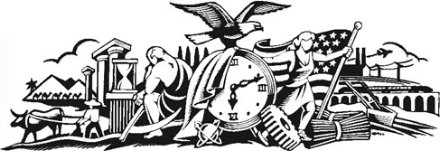
Newsdesigner.com has an interesting post enlightening us to the history of the ‘dingbat’, the vignette which can be found atop the International Herald Tribune.

The design first originated in the nameplate (also called, varyingly, the ‘masthead’, ‘banner’, or ‘flag’) of the New-York Tribune. The Tribune became the New York Herald Tribune, which my Aunt Naomi informs me was a very good newspaper while it lasted. The NYHT died in 1966, being merged into the ill-fated New York World Journal Tribune (aka the Widget) which only produced a few numbers before labor troubles killed it too.

The Herald Tribune, however, has two remnants which still exist today: the Paris edition (now the IHT) which continued under the auspices of the New York Times and the Washington Post, now solely owned by the Times; and New York magazine, which started out as a weekly supplement to the Herald Tribune.
MMV
Well the new year is finally upon us. I am very glad to say that this New Year’s Eve has been a very quiet and reserved one, perhaps appropriately enough given the recent catastrophes in Asia and Argentina. The hour was met calmly and quietly with Mom, Pop, Uncle Ed, and the requisite bottle of Veuve-Cliquot.
I previously had designs upon the usual rites of greeting the new year down in Manhattan, but found myself there last night (Dec 30) instead. Fellow Thorntonian Lev Trubkovich had a little event at his apartment in Stuyvesant Town — ostensibly to celebrate the recent Ukrainian highjinks — and I decided to be social for once and attend. Besides, there was pasta and chianti on offer, and I’ve rarely been one to turn down a free meal, even if it is at 11:00pm or thereabouts. There were in attendance an inordinate number of Columbians, but they seemed of a generally jovial character so it was all for the better really.
Last New Year’s Eve was spent in Pipa, a bar on 19th, with Clara and Lucas de Soto and a few others, and was altogether a much enjoyed evening. But this year having been out the previous night I hadn’t the stamina to go out tonight. I am, only somewhat regretably, becoming an old man.
And speaking of fellow members of the prematurely old, I had the immense pleasure of lunching just the other day with the one and only James J. Feddeck, that great proponent of Teutonic and Christian values. James is soldiering on as one of three or four conservatives at Oberlin College in Ohio. I am told that they meet secretly in a dimly-lit boiler room from time to time to watch the Fox News Channel, read the gender-specific translations of the Holy Bible, and fawn over portrait photographs of the late President Reagan. They are hoping the janitors do not find them out and report them to the President of the College, who, the day after the presidential election, sent out an official college e-mail to all the students, faculty, and staff assuaging them for the country’s loss, encouraging them to keep on trying, and telling them the election result shouldn’t dampen the Oberlin College spirit. Absolute insanity. Completely against the spirit of sportsmanship and fair play, if you ask me.
Herr Feddeck is also saddened that the new minister in charge of Village Lutheran is rather low-church. I thenceforth extolled the virtues of Rome, and he grumbled somewhat accordingly – albeit with a slight chagrin.
I’ve occasionally said that I don’t truly feel that I’ve returned home until I’ve heard the incantation of “Asperges me” at the 11:00am Mass at St Agnes, and I was most glad to have done so last Sunday. I rather regret that the obligation for tommorrow’s feast (today’s by now) is moved to Sunday, as we could all really do with some more time at Mass in our lives.
Well then, I guess I’d better wish you all the best for a blessed and joyful new year.
We remember those who have died this passed year, most especially Diane Gannon, my godmother, and Marylynn Heaton, my cousin. Eternal rest grant unto them, O Lord, and let perpetual light shine upon them. May they rest in peace. Amen.
Search
Instagram: @andcusack
Click here for my Instagram photos.Most Recent Posts
- Burns Tower April 19, 2024
- Patrick in Parliament March 18, 2024
- Articles of Note: 13 March 2024 March 13, 2024
- Cambridge March 9, 2024
- Taken on Trust March 4, 2024
Most Recent Comments
Book Wishlist
Monthly Archives
Categories


